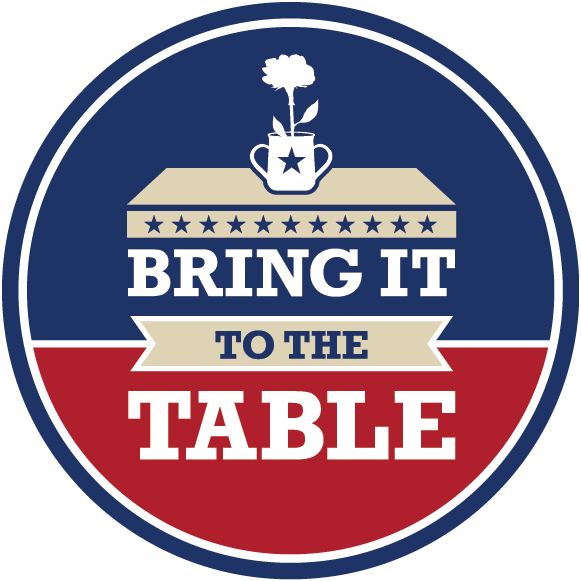Democracy is founded on robust dialogue
But somewhere along the line, politics replaced sex as the one thing in America we don't discuss in mixed company – even amongst friends and family. Segregating ourselves into political silos is toxic to democracy. Bring It to The Table encourages Americans to stop bickering about politics, examine their own assumptions, and truly engage in civil discourse to help move our democracy forward.
This project is a short documentary, webisode series, online platform, and community engagement campaign aimed at bridging political divides and breaking down partisanship. For people who are tired of hyper-partisanship, pull a chair up to The Table and join us in making politics an acceptable topic for dinner conversation again!
Bring It to The Table is produced by Talking Eyes Media, a non-partisan, non-profit organization with extensive experience producing films, books and multimedia on pressing social issues.
How it works
The Table is a citizen’s antidote to political ranting. From barbershops to ball fields, the locations are all familiar settings and the participants are randomly selected. (We swear we don’t use coercion, bribery or lobbying.) Anyone game enough to sit at The Table is invited to discuss pressing national issues, such as taxation, the economy, same-sex marriage, civil rights, abortion, religion, and immigration. People are asked to explain the roots of their beliefs so we understand WHY they believe WHAT they believe.
We’re interested to learn which of our beliefs cross over to the other side of the political spectrum? How have our opinions evolved over time? What does the other side get right? At The Table, ”ordinary” citizens are given an opportunity to speak their minds, openly and authentically. No ranting. No rhetoric. Just straight, honest talk that reveals the value systems behind our personal political views.
Hear Julie Winokur present her work with Bring It to The Table at the Mackinac Policy Conference
Everything's Personal
In 2012, filmmaker Julie Winokur’s 17-year-old son called her “the most intolerant person” he knows when it comes to politics. He said that whenever someone’s politics didn’t agree with hers, she dismissed what they had to say. Winokur was shocked. The accusation stopped her in her tracks. She realized that she had been called out on something that many Americans refuse to recognize: that we all contribute to divisive politics in America when we rely on assumptions rather than discourse. In fact, Winokur realized that she was as much to blame for the divisive tone of politics as the people whom she blamed. Rather than continuing to be part of the problem, she decided to become part of the solution.
Recognizing that it would be difficult to get people of different political persuasions around her own kitchen table, Winokur decided to bring her table to them. On a personal sojourn to unravel divisive politics in America, Winokur and her crew visited bookstores and barbershops, public parks and county fairs, Baptist churches and college campuses, inviting people to sit down and discuss the roots of their political beliefs. This project is as much about listening as it is about politics, perspectives and personal reflexes.
That Yellow Flower
Every participant who sits at The Table is seated in the same place and is filmed using a wide-angle lens. The effect is to make the viewer feel as though he/she is sitting at The Table with the participant.
A small yellow flower in a red vase is positioned at the center of The Table. At the beginning of each Table Talk, Winokur asks the participant to move the flower along the spectrum between conservative and liberal. From the participant’s perspective, Winokur makes conservative the extreme left and liberal the extreme right (which is reversed from the camera’s perspective). From the start, the participants’ assumption about right and left has been upended, while the viewer has an immediate visual cue to determine how each person self-identifies politically. This piece of information plays a critical role in shattering stereotypes and challenging semantics.
The consistency of The Table allows for creative license in bringing together diverse voices. While they have never met each other, the people at The Table speak to many of the same issues and lend themselves to a constructive dialogue.




